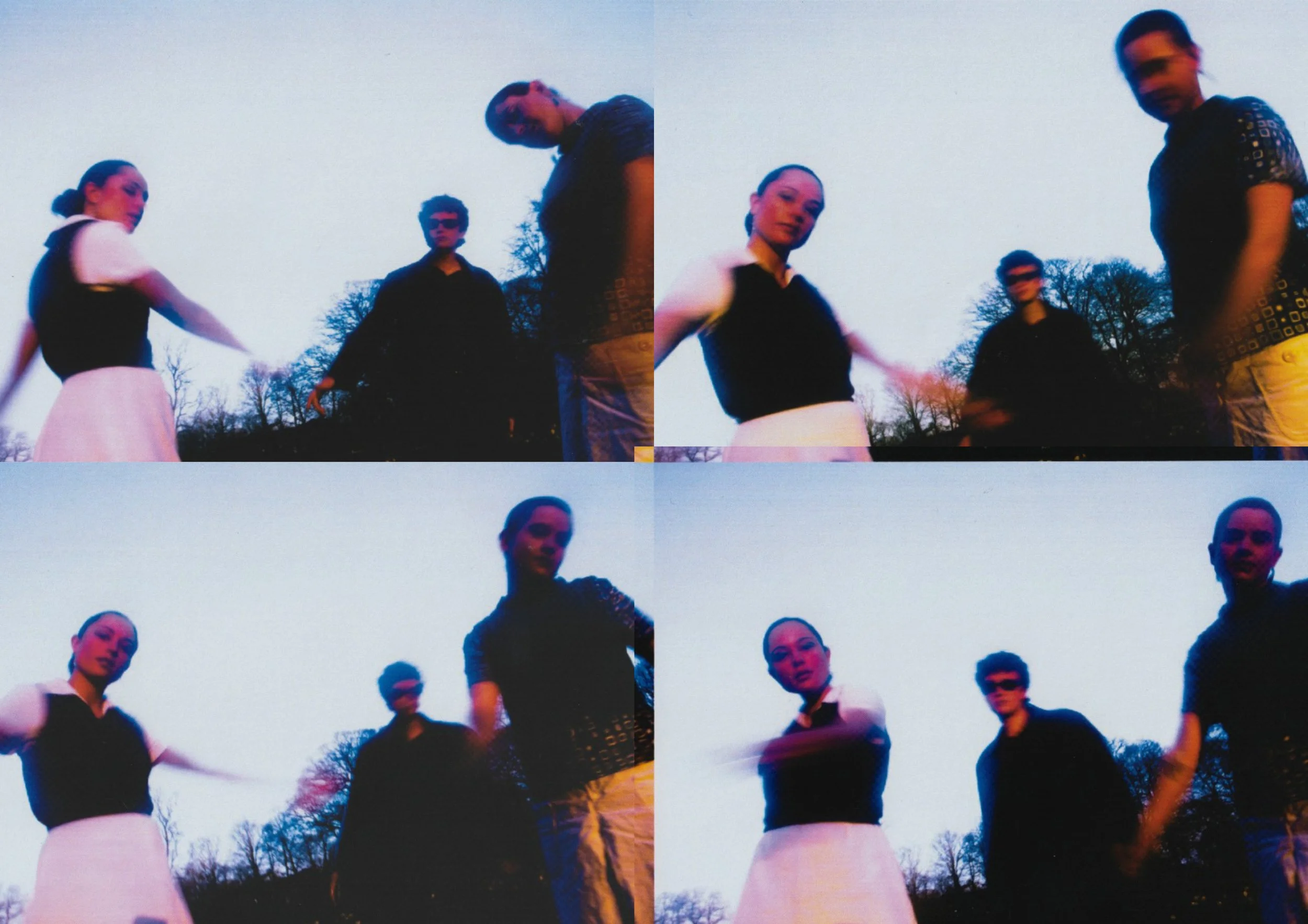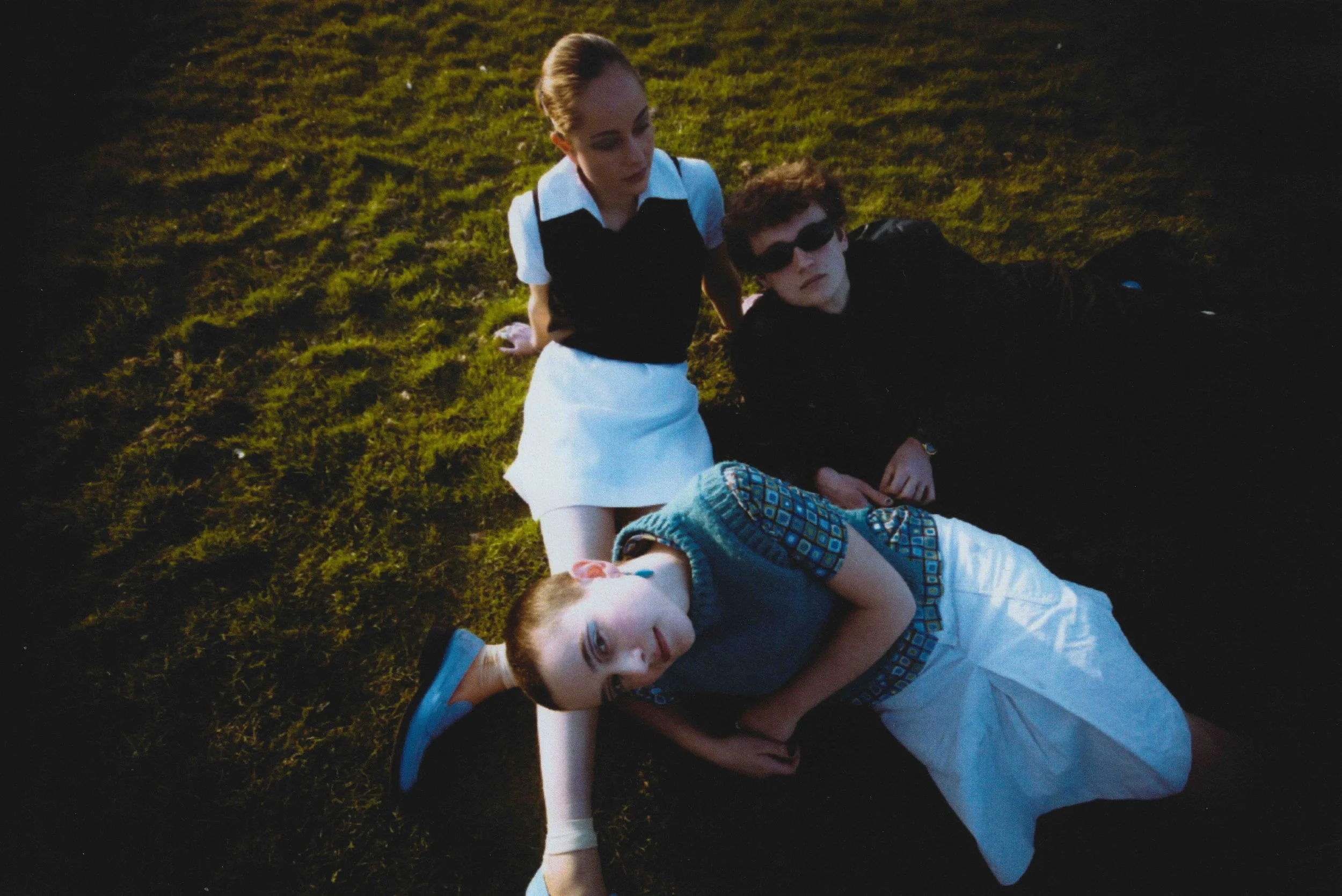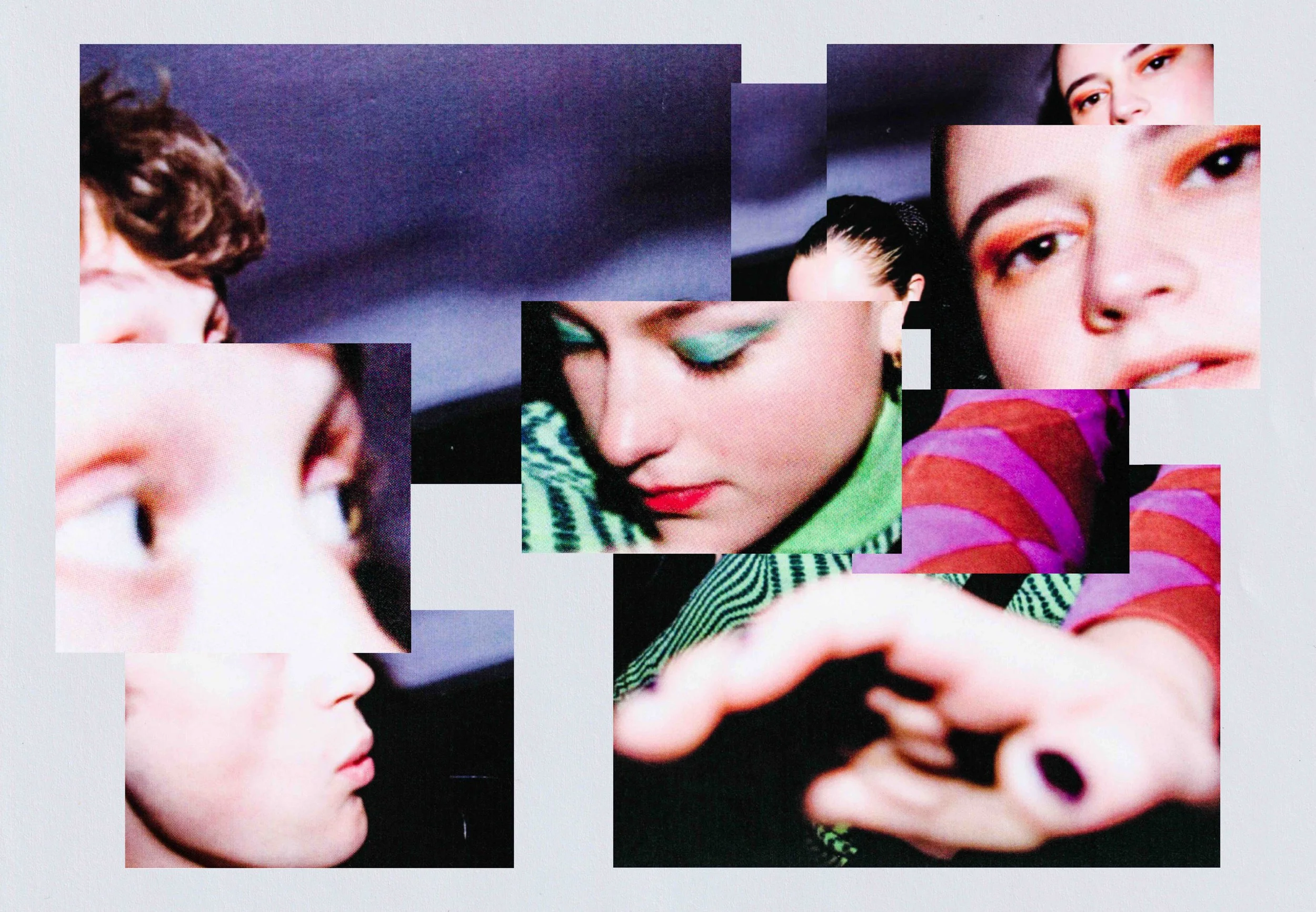Weekend Reading: The Orielles
Credit: Neelam Khan Vela
Revered American photographer Lee Friedlander said “If one really knew what one was doing, why do it”, a fitting statement that’s inherently reflective of the unusual process that led to the creation of The Orielles’ latest album, ‘Tableau’; a collection of tracks amassed, developed, broken and rebuilt over a few years worth of sonic discovery for the Halifax trio.
However, their connection to the cultural icon Friedlander doesn’t end there. His work, courtesy of an exhibition visit from guitarist and vocalist Esme, who isn’t present for our chat, also served as the inspiration behind the album’s name. It’s these cultural strings that The Orielles are so good at drawing from; the worlds of art, literature and cinema are sipped from in delectable quantities by Sid, Henry and Esme, providing them with an artistic foundation, on which they’ve constructed their own organic path; one without forced musical labour, instead furnishing themselves with the space to be creatively free.
Since forming in the deep underbelly of West Yorkshire, The Orielles have traversed several sonic planes; from their early DIY lo-fi origins to creating a new and modern brand of avant-garde, jazz-influenced expressionism, their latest body of work is their most ambitious yet. Creating music they’d share with each other, powered by oblique practices and heavily driven by in-jokes that nor you or I will ever be a part of, the telepathic three-piece are just hitting their stride. In their own words, “this isn’t the end… it’s just the beginning.”
A lot changed for you guys on ‘Tableau’, different ways of writing and recording being the primary factors that led to the creation of this new sound you’ve sonically embraced, was this a conscious decision?
Henry: Yeah, we decided to do this one differently and not demo or overwrite with the intention of doing it in the studio…because what we found was if we demoed and then had to wait to record, and then eventually release it and tour it, the songs were so old by the time we do like the first UK show, especially because of the wait time for vinyl. It kind of didn’t make any difference whatsoever. Like ‘beam/s’ was written in December 2020; when we first started to jam after not meeting up for the purpose of doing days in a studio. We broke new ground on all of it; there’s a bunch of tunes that were jammed in that time that became finished songs at the end.
Sid: One of the ways in which we find it very easy to write together is through being on tour and it comes from that downtime you get and sound checks and stuff, and with that obviously not being possible during the pandemic; once we’re in a room together the ideas are flowing instantly. Hopefully, we’ll break into a bit of a different kind of fan base as well, that more left-field scene that we’ve hopefully entered. Particularly through lockdown, getting into buying records again and showing each other new music opened our ears to more left-field ideas and sounds.
“We definitely unlocked so many things that we can do that we didn’t realise we could do within a studio environment”
Around the time of the album’s release, I read a quote from Pete Paphides that eluded Arctic Monkeys and Radiohead are the only two bands in the country making albums that members of those bands truly want to hear... on my first listen of to ‘Tableau’ I thought well can’t be true, he needs to listen to this (no shade intended on Pete, who’s one of our favourite music writers). Do you think you've unlocked a more experimental side to recording and writing than you had before?
Henry: We definitely unlocked so many things that we can do that we didn’t realise we could do within a studio environment. So I remember, towards the end, when we remixed the album, we were noticing things we could do next time to remember the process to try out. So I think it’s just the start; having full control was such a good way to learn all these things. I think you hit the nail on the head though, because we are incredibly proud of the album, and we would listen to the songs and share them with each other. It’s just for us this album, so what see if people listen to it?
I’m interested in where the name came from... ‘Tableau’.
Henry: It’s a lyric from ‘Darkened Corners’. Which is based on a Lee Friedlander exhibition Esme went to, the exhibition was about how Lee is often in his own pictures as a shadow or reflection; the songs are based around that. Then, the line “am I the maker of this tableau” stuck out when we were thinking about the name... we’d had a three-word album, and a two-word album, so it made sense for this to be one word.
Credit: Neelam Khan Vela
You instituted a particular way of recording on ‘Tableau’ dubbed the “Goyt method”. Can you explain what this is and how it developed?
Sid: We got asked to remix an ACR track and one from The Lounge Society around the same time. So we went to Joel Patchett; it was the first time working with Joel I guess on a very practical level.
Henry: So it was basically like recording things, and then chopping them up to be more rhythmic or allowing the computer to decide what these new rhythms are going to be. It’s hard to explain actually, isn’t it? It’s more about recording acoustic sounds, dropping them off in a digital way, and then we work through them.
Sid: Yeah, reprocessing in a way that’s got an element of AI involved. We came up with the term “to Goyt it”. Now when we're writing music or playing with Joel we just say “Goyt it”. It’s just become our own term for that particular process. It ties in with what we did for ‘beam/s’; we drew a graphic score for Joel because he was playing the arpeggio modular stuff, whilst we were recording acoustic instruments. And I guess that in itself, allowed him to interpret our random drawings of words and cues, which were extremely random.
Henry: We gave him very little to go off... we just said “it’s an A minor”. We wanted textural, gestural things rather than melodies; it was just about communication and seeing how he would interpret it and that allowed us to be happy with the result because it’s part of the process. Like, we’d left a lot of it to chance because when we did the demos they were just ten-minute-long room jams. We went into the studio with very loose everything. Joel’s also really good at knowing when to walk away. So we went on a big walk, had a mega-long break and then went back down to the studio at around midnight. Joel made us all shut our eyes and then shuffled us around and then chose us one by one to go into the live room with the instruction to pick up an instrument you wouldn’t think to pick up; so that was a complete chance. We learned not to be too precious about things and that mistakes sit within what we've created. “Don’t polish it” was the mantra.
“We started to listen to a lot of new stuff like really intricate like EDM. There’s so much to wrap your head around. With guitar music, you can basically figure it all out if you sat down for an hour”
You’ve mentioned it briefly but in your album biography the phrase “zero ground” crops up a lot, that immediately drew my attention; as much as this is a departure of sorts from the last album, is it more of a starting point for where you want to go musically?
Henry: Yeah, that’s what we thought when we finished it, this is how we want to continue, it’s not the big end piece.
Sid: Yeah, for sure. Like listening to a lot more electronic music than we have done in the past. The ways in which we write and then tie that into “The Goyt” thing as well. Diverting from the typical guitar-based music that we’ve done in the past.
Henry: I think that all of that side of it came from just listening to genuinely contemporary electronic music; we started to listen to a lot of new stuff like really intricate like EDM. There’s so much to wrap your head around. With guitar music you can basically figure it all out if you sat down for an hour; it’s just got a bit more complexity to it.
You’ve talked about leaving mistakes in the record quite a bit. Why are they important to leave in… are they like little sort of bookmarks within the album?
Henry: Absolutely. I feel like when I really love a tune, and you listen to it a lot, and then obviously you find a mistake, it makes it so much better. Because it’s more human, you feel super important. I can play it back and point out loads on ‘Tableau’, but I love them.
Sid: And as our good friend Jez Kerr taught us, it’s not a mistake if you play it twice.
Credit: Neelam Khan Vela
You mentioned getting into electronic music… you produced your own show on Soho Radio for a while. Did those sonic influences you showcased on the show feed into the album?
Henry: Massively, because we always talk about making playlists, sharing with each other what you’re listening to so you can be on the same page. But having that every month was great for discovering new music. I started to buy more records; it became like a competition between us all. It pushed us all into discovering these mad new things. We’d talk about how it was made, about the actual physical thing and that was really good for inspiration.
Sid: Even on a basic level, mixing two records together is kind of the way that inspired some of the album’s flow and there are jump takes from one that goes into another. So it kind of brings it all to life when you’re doing a DJ set.
Henry: We’d go down one route because we all follow each other, but occasionally, someone would put on something completely unexpected, a real curveball, and it would send the whole show in a different direction. So it’s dead like the album; you feel secure in where it’s going, and then you’re just given a whole new environment to be in. We always joked that if anyone has listened through the shows since 2020, they’d know exactly what the new album was going to sound like.
The title of the album comes from the world of art and minimalism. How does mixed media… literature, design, and cinema influence your writing?
Henry: You can pull so many parallels between them all, but they’re all basically about expression and balance. By balance, I mean chaos and serenity; that’s the spectrum where everything sits between. So I remember speaking about our songs in a way where you’d have the mad rapid... like ‘Darkened Corners’, we’ve got absolute chaos, and then it settles down into this sense of calm. Besides the visual scores, you can draw it all out, it’s basically about that. Tension and release. That’s what we said anyway.
Sid: For me, a big influence for this one was the graphic score idea that we created with Joel, drawing out a visual representation for each track, but there’s a jazz musician called Wadada Leo Smith; I got into his work a few years ago. He would write his own music and then would draw a graphic score for his class or the session players that he was playing with. So I guess that’s a way that we’ve always written when we were first-ever jamming together years ago. We would put on a film in our practice room and just jam to that; the ebbs and flows of the narrative.
“I’d say… in a not in an egotistical way, we kind of did everything right. I wouldn’t really want to change many things. I think working our asses off has meant that we are very humble about what we do”
To briefly speak about your Calder Valley roots; there seems to be a conveyor belt of bands coming out of that area of the world since you came onto the scene. Is it nice from your perspective to know that other people want to follow in your footsteps?
Henry: Yeah, definitely. In 2022, Working Men’s Club, The Lounge Society, and us, all had albums out. It’s been such a good year for the Calder Valley music scene. Then you’ve got The Short Causeway coming through as well. It’s great. I went to see The Lounge Society recently; I was standing at the back and I didn’t recognise anyone… three years ago, that would have been me. It’s so nice to see the appetite for it, and the successes coming out of that area.
Now, it’d be silly not to talk about your live performances. Are you looking forward to getting back on the road again? What do you like about touring?
Henry: It’s always a great time, we used to tour a lot more around the first album. It was just a great way to travel and see people. If you choose your touring party well, everything’s fine. Go off like vibes, man. Morale, man. It’s been really exciting reworking this album for the live shows because we’ve always had the doctrine that live and recorded should be different. There’s been a lot of freedom in just seeing how we can build the same song but in a live setting. I’m very excited about it.
Lastly, when you reflect on things, is there anything from the last decade or so that you’d change or do differently?
Sid: I’d say… in a not in an egotistical way, we kind of did everything right. I wouldn’t really want to change many things. I think working our asses off has meant that we are very humble about what we do, and we love our music. We’ve kind of built our way up very naturally. There have never been any forced moments.



